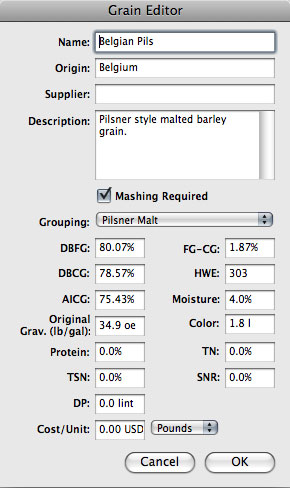Grains: Difference between revisions
No edit summary |
|||
| (9 intermediate revisions by 3 users not shown) | |||
| Line 1: | Line 1: | ||
There are characteristics of grain that vary with each crop and where it was grown, etc., as well as variations that are caused by how it was malted. That information can generally be obtained from a Malt Analysis sheet that sometimes accompanies the grain (at least for very large orders such as for commercial breweries). BTP presumably uses that information (at least some of it) for it calculations. | |||
The BTP grain database contains information about most popular grains from many suppliers, but users also have the ability to 'add' new grains, and to 'edit' existing grains (or new ones) to make changes in that information. That information should ideally come from the analysis sheet provided by the maltster, but ''might'' be obtained from a website, etc. Eventually I hope we can obtain a list of the absolutely ''essential'' fields needed by BTP for its calculations. | The BTP grain database contains information about most popular grains from many suppliers, but users also have the ability to 'add' new grains, and to 'edit' existing grains (or new ones) to make changes in that information. That information should ideally come from the analysis sheet provided by the maltster, but ''might'' be obtained from a website, etc. Eventually I hope we can obtain a list of the absolutely ''essential'' fields needed by BTP for its calculations. | ||
==Browser== | |||
[[Image:grain.jpg]] | |||
==Editor== | |||
{| | |||
|valign="top"|The following fields appear on the Grain Editor panel, with the following meanings/purposes (some technical information was obtained from this [http://brewingtechniques.com/bmg/noonan.html Article] by Greg Noonan). | |||
;Name | |||
:self-explanatory | |||
;Origin | |||
:country or region where grown | |||
;Supplier | |||
:manufacturer or grower | |||
;Description | |||
:comments on distinctive characteristics of the ingredient | |||
;Grouping | |||
:drop-down menu for you to indentify the type of grain/malt | |||
;DBFG | |||
:Dry Basis Fine Grind; this is a value which represents the maximum amount of yield which can be extracted, under laboratory conditions, from the grain; measured as a percentage of the weight of the grain; below 78% DBFG extract is considered substandard | |||
;DBCG | |||
:Dry Basis Coarse Grind; More closely approximates the typical crush achieved in breweries, and therefore gives a better indication than DBFG of the extract potential of the grain | |||
;FG-CG | |||
:Fine Grind Coarse Grind Difference | |||
:(DBFG - DBCG) ÷ DBFG | |||
;HWE | |||
:Hot Water Extract expressed in liters-degrees per kilogram | |||
;AICG | |||
:As-Is Coarse Grind or Extract As Is; this is the extract yield including moisture content | |||
;Moisture | |||
:the amount of water that was present in the malt at time of analysis; normally less than 6% | |||
;Potential Extract | |||
:potential [[Original Gravity]] one pound in one gallon | |||
;HCU | |||
:color measured in degrees [[EBC]] or [[SRM]] [[Lovibond|(Lovibond)]] | |||
;Protein | |||
:Protein as percent weight; levels of 11-13% in six-row malts and 8-10% in two-row malts are considered acceptable | |||
;TN: | |||
:Total Nitrogen; approximately 16% of the protein weight is nitrogen | |||
:TN ≈ Protein ÷ 6.25 | |||
;TSN | |||
:Total Soluble Nitrogen expressed as a percentage of total nitrogen (TN) | |||
;SNR | |||
:Soluble Nitrogen Ratio or ratio of soluble protein to total protein (S/T) | |||
;DP | |||
:Diastatic Power | |||
:the enzymatic power of the malt | |||
;Cost/Unit | |||
:unit cost of the ingredient | |||
[[Image: | |valign="top"|[[Image:Grained.jpg|Grain editor]] | ||
|} | |||
==See also== | ==See also== | ||
| Line 57: | Line 80: | ||
* [[Yeasts]] | * [[Yeasts]] | ||
* [[Special Ingredients]] | * [[Special Ingredients]] | ||
* [[Water]] | |||
* [[Mineral Salts]] | |||
Latest revision as of 02:32, 1 April 2008
There are characteristics of grain that vary with each crop and where it was grown, etc., as well as variations that are caused by how it was malted. That information can generally be obtained from a Malt Analysis sheet that sometimes accompanies the grain (at least for very large orders such as for commercial breweries). BTP presumably uses that information (at least some of it) for it calculations.
The BTP grain database contains information about most popular grains from many suppliers, but users also have the ability to 'add' new grains, and to 'edit' existing grains (or new ones) to make changes in that information. That information should ideally come from the analysis sheet provided by the maltster, but might be obtained from a website, etc. Eventually I hope we can obtain a list of the absolutely essential fields needed by BTP for its calculations.
Browser
Editor
The following fields appear on the Grain Editor panel, with the following meanings/purposes (some technical information was obtained from this Article by Greg Noonan).
|

|
